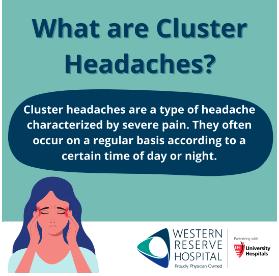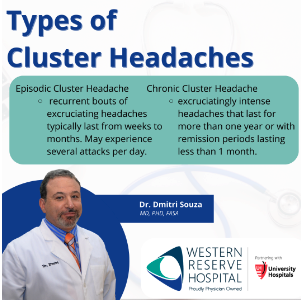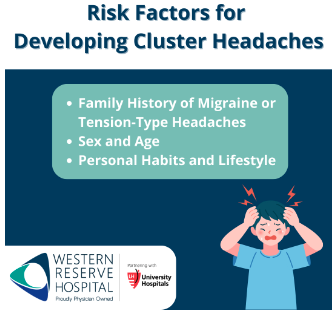A cluster headache is a neurological disorder characterized by recurrent bouts of excruciatingly intense types of headaches. It is among the most painful conditions known to medicine and can be extremely debilitating for those affected. In this blog post, we will explore what it means to have a cluster headache, its causes, and its symptoms. We will also explore the process of diagnosing and treating this disorder.
What are Cluster Headaches?
Cluster headaches are a type of headache characterized by severe pain. The term cluster headache is derived from the fact that these headaches occur in clusters, meaning they often occur on a regular basis according to a certain time of day or night.

Causes of Cluster Headaches
The exact cause of these painful headaches is unknown, however, there are some potential risk factors that may increase the likelihood of developing the condition. These risk factors include a family history of migraine or tension-type headaches, sex and age, personal habits and lifestyle, and certain medical conditions such as sinusitis or allergies. Additionally, it is thought that abnormalities in brain chemicals may also play a role in the development of cluster headaches.
Types of Cluster Headaches
Cluster headaches can be divided into two main categories: episodic and chronic. Episodic cluster headaches occur in clusters that last from weeks to months, with the sufferer experiencing several attacks per day during the cluster period. On the other hand, chronic cluster headaches are defined as those lasting for more than one year or having more than 8 attacks per day on average.
Episodic Cluster Headache
Episodic cluster headache is a neurological disorder characterized by recurrent bouts of excruciatingly intense headaches. These headaches usually occur in clusters and are often accompanied by restlessness or agitation. Symptoms typically last from weeks to months, and during the cluster period, an individual may experience several attacks per day.
Chronic Cluster Headache
Chronic cluster headache is a neurological disorder characterized by recurrent bouts of excruciatingly intense headaches that last for more than one year or with remission periods lasting less than 1 month. These headaches usually occur in clusters and can be extremely debilitating for those affected.

Diagnosis of Cluster Headaches
The diagnosis of cluster headaches is typically made based on a patient's symptoms and medical history. To reach a diagnosis, a doctor will usually perform a physical exam to look for signs such as conjunctival injection, lacrimation, nasal congestion, rhinorrhea, eyelid oedema, forehead and facial sweating, forehead and facial flushing, and a sensation of fullness in the ear. Additionally, a doctor may order imaging tests such as an MRI or CT scan to rule out other potential causes of headaches.
Risk Factors for Developing Cluster Headaches
While the exact cause of these severe headaches is unknown, there are certain risk factors that may increase an individual’s likelihood of developing them. These include a family history of migraine or tension-type headaches, sex and age (men between 20 and 40 years old are at greater risk), personal habits and lifestyle (such as smoking or alcohol consumption), and certain medical conditions such as sinusitis or allergies. Additionally, it is thought that abnormalities in brain chemicals may also play a role in the development of cluster headaches.
Family History of Migraine of Tension-Type Headaches
Family history of migraine or tension-type headaches is thought to be one of the potential risk factors for developing cluster headaches. Those who have a family history of either migraine or tension-type headaches may be more likely to develop cluster headaches. This is because certain genetics and environmental factors may play a role in the development and progression of these conditions, including those that contribute to cluster headaches. Research suggests that individuals who have a family history of migraine or tension-type headaches may be more likely to experience cluster headaches than those without a family history.
Sex and Age
Sex and age are both risk factors for developing cluster headaches. Men between the ages of 20 and 40 are at greater risk for developing cluster headaches than women or those outside of this age range. This is likely due to hormonal changes that occur in men during this period of life which may contribute to the development of cluster headaches. Additionally, hormones in women tend to be more stable during this time frame which may help protect them from cluster headaches. Therefore, it is important to be aware of these risk factors when considering a diagnosis of cluster headaches.
Personal Habits and Lifestyle
Personal habits and lifestyle are also thought to be potential risk factors for developing cluster headaches. Smoking, alcohol consumption, and certain medications may increase the likelihood of developing cluster headaches. Additionally, stress or emotional disturbances, sleep deprivation, and poor dietary habits can all contribute to a person's risk of developing cluster headaches. It is important to be mindful of these risk factors when considering a diagnosis of cluster headaches.

Treatment Options for Managing Cluster Headaches
Cluster headaches can be difficult to manage, but there are several treatment options available. Medication is typically the first line of treatment and includes drugs such as triptans, opioids, and anti-inflammatory medications. Additionally, lifestyle changes such as reducing stress and avoiding triggers (such as alcohol or certain foods) may help to reduce the frequency and severity of cluster headaches.
In more severe cases, other treatments for cluster headaches may be recommended. Cluster headaches can be difficult to manage, but with the right treatment plan and lifestyle modifications, they can be controlled.
When to Seek Medical Help
The symptoms of cluster headaches can be difficult to manage and should not be ignored. If you are experiencing any of the symptoms associated with cluster headaches, such as intense pain on one side of your head and eye, it is important to seek medical attention right away. Your doctor may recommend lifestyle changes and medications to help manage your symptoms. Additionally, if you have a family history of migraine or tension-type headaches, it is important to discuss this with your doctor as this may increase your risk for developing cluster headaches.
Pain Medicine at Western Reserve Hospital — 100% Patient Centered Pain Treatment
You don’t have to suffer from cluster headaches. At the Center for Pain Medicine at Western Reserve Hospital we provide the latest innovations in comprehensive pain treatment.
When chronic pain sets in, your life shrinks to fit your pain. Your health, work, and relationships suffer. You become less active. Often, you cannot sleep or suffer from depression. Living with chronic pain is hard, and the anxiety, stress, and anger that accompany it can make the pain even worse. The pain specialists at the Center for Pain Medicine at Western Reserve Hospital can help you conquer your pain with sophisticated new treatments and compassionate, professional care. Contact us at (330) 971-7246 to schedule an appointment and begin the journey to pain relief today.
